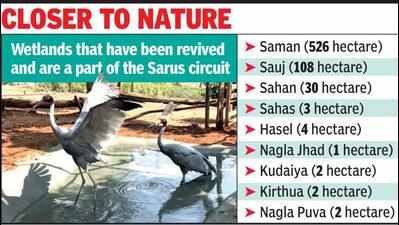- News
- City News
- lucknow News
- Mainpuri’s Sarus circuit to be major attraction for eco-tourists
Trending
This story is from June 4, 2021
Mainpuri’s Sarus circuit to be major attraction for eco-tourists

Lucknow: UP's Mainpuri district, home to the biggest population of Sarus cranes in the country, will soon see a Sarus circuit as a major eco-tourism project. The circuit, which will have over a dozen wetlands and a bird sanctuary, is ready and would be thrown open to the public once the restrictions due to Covid-19 are lifted, said a state government official.CDO, Mainpuri, Eesha Priya said, "It's an eco-tourism project and, at the same time, a step towards conservation branding. It will help conserve Sarus and give eco-tourists a reason to visit Mainpuri." The first phase of the three-round Sarus census had counted over 2,866 Sarus in Mainpuri in September last year.
The circuit will connect two blocks of Mainpuri, Kishni and Karhal, and spread over 676 hectare, including around 526 hectare of Saman bird sanctuary which is also a Ramsar site (a wetland with international recognition), a forest department official said.
About a dozen wetlands which lie outside Saman but are part of the circuit cover over 152 hectare. "If you enter Karhal, which has Lucknow-Agra Expressway passing through it, you would see three of these wetlands close to each other," said the CDO.
Kishni and Karhal had several of its wetlands lost due to encroachment, illegal cultivation and other factors over a period of time. Mainpuri is also a place of natural depression. Some of the wetlands in the past had been given away as 'patta' to people.
In Mainpuri, after the district administration started reviving and digging the lost wetlands, in December last year, Sarus were seen returning to these sites. "We did not use JCB to dig the machines but it was done under MNREGS, involving local labourers, who would also take pride in the kind of work they are doing," said the CDO.
Sarus could be seen at these wetlands at present. About a dozen of these wetlands are connected to the web of canals and would have enough water to support the population of Sarus and other migratory birds. "It is, in a way, a community-driven project. We are making gram pradhans own it up. They would make watch towers on the circuit for the visitors. It's a bottom-to-top mode of development," said Priya.
The point to make the project also economically beneficial for the locals would, however, come up for consideration only when the tourists start coming and footfalls increase. There might be a ticket put for a watch tower or at the entry of the circuit. "It has to be decided by the local bodies," said the official.
The circuit will connect two blocks of Mainpuri, Kishni and Karhal, and spread over 676 hectare, including around 526 hectare of Saman bird sanctuary which is also a Ramsar site (a wetland with international recognition), a forest department official said.
About a dozen wetlands which lie outside Saman but are part of the circuit cover over 152 hectare. "If you enter Karhal, which has Lucknow-Agra Expressway passing through it, you would see three of these wetlands close to each other," said the CDO.
Kishni and Karhal had several of its wetlands lost due to encroachment, illegal cultivation and other factors over a period of time. Mainpuri is also a place of natural depression. Some of the wetlands in the past had been given away as 'patta' to people.
Sarus and other migratory birds used to flock to these wetlands. It is noteworthy that conservationists cite habitat destruction as the biggest threat to the population of Sarus which is known to stay at its habitat for the entire lifetime till it is forced to leave the site.
In Mainpuri, after the district administration started reviving and digging the lost wetlands, in December last year, Sarus were seen returning to these sites. "We did not use JCB to dig the machines but it was done under MNREGS, involving local labourers, who would also take pride in the kind of work they are doing," said the CDO.
Sarus could be seen at these wetlands at present. About a dozen of these wetlands are connected to the web of canals and would have enough water to support the population of Sarus and other migratory birds. "It is, in a way, a community-driven project. We are making gram pradhans own it up. They would make watch towers on the circuit for the visitors. It's a bottom-to-top mode of development," said Priya.
The point to make the project also economically beneficial for the locals would, however, come up for consideration only when the tourists start coming and footfalls increase. There might be a ticket put for a watch tower or at the entry of the circuit. "It has to be decided by the local bodies," said the official.
End of Article
FOLLOW US ON SOCIAL MEDIA










